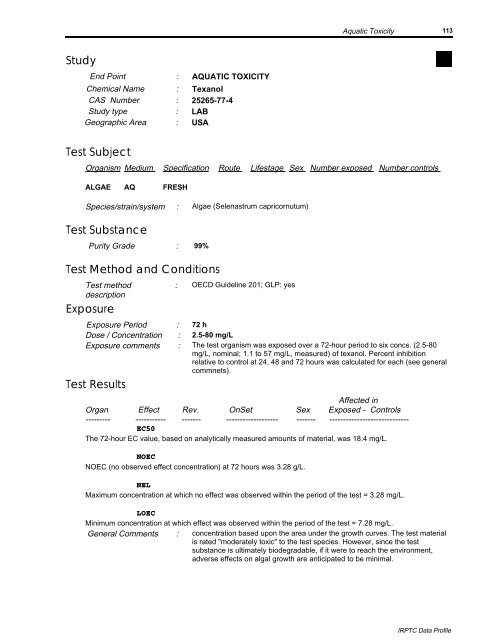TEXANOL CAS N°: 25265-77-4
TEXANOL CAS N°: 25265-77-4
TEXANOL CAS N°: 25265-77-4
Create successful ePaper yourself
Turn your PDF publications into a flip-book with our unique Google optimized e-Paper software.
Aquatic Toxicity 113<br />
Study<br />
End Point : AQUATIC TOXICITY<br />
Chemical Name : Texanol<br />
<strong>CAS</strong> Number : <strong>25265</strong>-<strong>77</strong>-4<br />
Study type : LAB<br />
Geographic Area : USA<br />
Test Subject<br />
Organism Medium Specification Route Lifestage Sex Number exposed Number controls<br />
ALGAE<br />
AQ<br />
FRESH<br />
Species/strain/system : Algae (Selenastrum capricornutum)<br />
Test Substance<br />
Purity Grade : 99%<br />
Test Method and Conditions<br />
Test method :<br />
description<br />
Exposure<br />
OECD Guideline 201; GLP: yes<br />
Exposure Period : 72 h<br />
Dose / Concentration : 2.5-80 mg/L<br />
Exposure comments : The test organism was exposed over a 72-hour period to six concs. (2.5-80<br />
mg/L, nominal; 1.1 to 57 mg/L, measured) of texanol. Percent inhibition<br />
relative to control at 24, 48 and 72 hours was calculated for each (see general<br />
commnets).<br />
Test Results<br />
Affected in<br />
Organ Effect Rev. OnSet Sex Exposed - Controls<br />
--------- ----------- ------- ------------------- ------- -----------------------------<br />
EC50<br />
The 72-hour EC value, based on analytically measured amounts of material, was 18.4 mg/L.<br />
NOEC<br />
NOEC (no observed effect concentration) at 72 hours was 3.28 g/L.<br />
NEL<br />
Maximum concentration at which no effect was observed within the period of the test = 3.28 mg/L.<br />
LOEC<br />
Minimum concentration at which effect was observed within the period of the test = 7.28 mg/L.<br />
General Comments : concentration based upon the area under the growth curves. The test material<br />
is rated "moderately toxic" to the test species. However, since the test<br />
substance is ultimately biodegradable, if it were to reach the environment,<br />
adverse effects on algal growth are anticipated to be minimal.<br />
IRPTC Data Profile
















